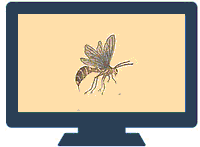Entomology, Department of

Department of Entomology: Distance Master of Science Projects
Date of this Version
2019
Document Type
Project
Citation
University of Nebraska-Lincoln Department of Entomology Online Masters Program Final Project. Lincoln, Nebraska.
Abstract
This project was based on observations at my residence located in the 68510 zip code of Lincoln, Nebraska. Keeping a journal of observations beginning April 26, 2019 and ending on September 28, 2019, I made entries at least twice a week. I often observed the area more than twice a week to check for different insects than what had been journaled. Journal entries were usually made during late morning to mid-afternoon, as this timeframe seemed to provide the most insect activity. Incidental observations were usually made early morning, and late afternoon to evening. In general, populations of insect families were constant based on time of day, weather conditions, and time during the season. A few more families of moths were observed in October, but I didn’t include them in the study. Two annual plants that I specified in my project proposal (zinnia and cosmos) were thrown out of the study due to failure to germinate properly. However, one additional shrub (Heptacodium miconioides) and six additional perennials were added. These additional perennials indicate that more is at play than just having a large area of specific blooms, as these plants are all just establishing in the landscape, and one was still potted, yet insects were rich and/or abundant on them. The additional perennials are Agastache, Linaria, Calamintha, Pycnanthemum, Eryngium yuccifolium, and Parthenium integrifolium. The last three were particularly attractive to wasps. Identification of insects was based on insects I collected earlier to this study, as well as reference to bugguide.net, ENTO 818 course information, and Borror and DeLong’s Introduction to the Study of Insects, 7th Edition, (Triplehorn & Johnson, 2005). Insects I didn’t catch, and was unable to identify based on observation, were not used for the guide, although I did notate additional unidentified orders in my raw numbers. I also strived to understand behaviors of insects to more easily identify them during observation. In addition, although not an insect, I included Araneae in my data. For frame of reference, I would observe flowers in bloom on walks in my neighborhood, as well as on walks adjacent to the downtown Lincoln area while on breaks during my full-time job. I also visited Backyard Farmer Garden and UNL East Campus two times, and the UNL campus downtown. Based on these observations, there appears to be more at stake regarding insect richness and abundance than just having the right kind of plants available. This is something worthy of more study in order to create optimal habitat while also keeping landscapes to a desired level of maintenance and feasibility. From these other observations, I also found a disconnect between the abundance of honey bees and native bees, whereas, the abundance of honey bees often meant the lack of native bees. I’m not sure why, but I would postulate managed hives may be kept close to areas where they are more prevalent, while native bee habitat is missing in those areas, as it didn’t seem to be a nectar/pollen source issue. Data I’ve collected is currently stored in Excel, and more data can be compiled based on my journal entries. With the data compiled so far, the top five perennials for insect diversity (based on identified families) are Allium, Asclepias, Rudbeckia, Calamintha, and tied at fifth, Solidago and Echinacea. Adding in the number of unidentified families, the list shifts a bit to Asclepias, Allium, Rudbeckia, Calamintha, and tied at fifth place, Solidago and Aralia. The shrub showing the most insect diversity from the study is Physocarpus. Although Rudbeckia, Echinacea, and Physocarpus are all common plants in the landscaping industry, it must be noted that this study doesn’t differentiate between species and/or cultivars of these plants, and as such, variability may be seen between the different species and/or cultivars. Sorting the data by plants with the highest percentage of pollinators, the list shifts dramatically. One of the top plants in this category is Tagetes (Marigold), an annual variety, and while it had a high percentage of pollinators, the pollinators visited this flower most at the end of the growing season when fewer options were available and were visited most often by Lepidoptera. The top five perennials are Sedum, Eryngium yuccifolium, Caryopteris, Pycnanthemum, and Salvia. Sedum and Salvia are readily available at greenhouse and other establishments that carry landscape plants, as well as commonly used in the landscaping industry. The top shrub, which may also grow into tree form, Heptacodium miconioides, is not readily available, but the second highest, Buddleia, is widely available. While this data shows the attractiveness of different insect families to different types of plants, it is only one variable in the multitude of factors that create good insect habitat, especially when other parameters need to be met, such as availability of plants, land use, landscape maintenance, and acceptance of particular insect families. Through the compilation of data, and the use of spatial/geographic analysis, we could better understand how the different variables fit together within the different parameters in order to design landscapes that work for both insects and humans. Seeking out existing variables that are conducive to providing insect habitat may prove more useful than just growing specific varieties of plants, as doing so might not provide everything needed for insect richness or abundance. Understanding the variables and parameters that need to be met for each tract of land to be landscaped will provide a higher degree of success. In addition, continuing to educate and foster an appreciation for the diversity of insects is essential. A good example for this connection is the tolerance of aphids to bolster a population of ladybird beetles. Perhaps moving beyond a label of pollinator-friendly on a plant is needed to ensure we don’t lose more species of insects.


Comments
Copyright 2019 Shelley Rekte